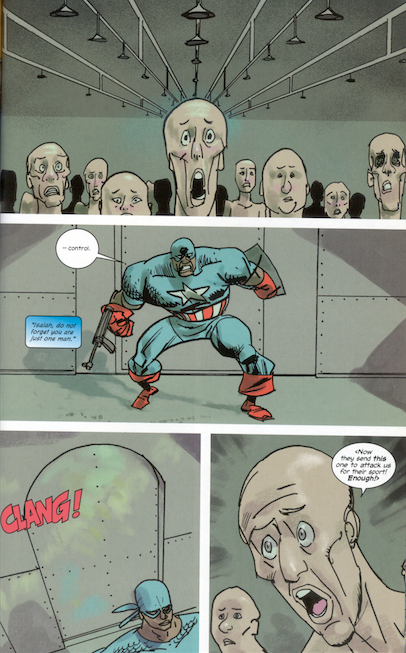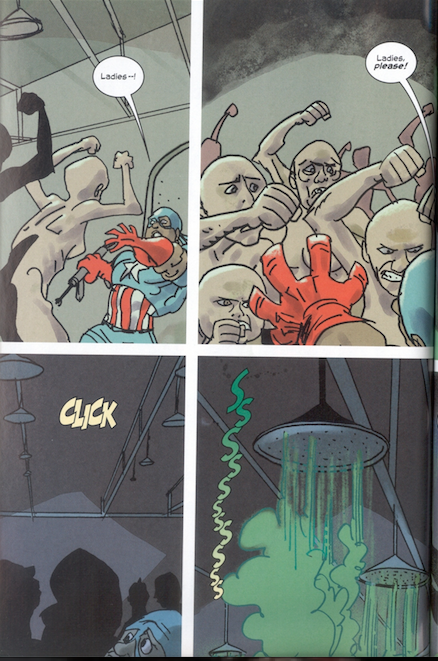I published a piece at Playboy yesterday about the new revelation that Captain America is part of Hydra. I mostly talked about Truth: Red, White, and Black, the miniseries by Robert Morales and Kyle Baker, which imagines the supersoldier serum tested on a group of black soldiers in a Tuskegee-like experiment.
Anyway; one thing I wanted to get into the piece but couldn’t quite fit was a discussion of this sequence.
Isaiah Bradley, the one survivor of the supersoldier experiment, has been sent on a suicide mission in Germany. In the course of his effort to destroy the Nazi supersoldier project, he attempts to rescue Jews from a gas chamber. They don’t realize he’s trying to rescue them, though. In fact, they think the Nazis have sent him to rape them. Their confusion, it is implied, is caused by the fact that he is black. In short, the comic presents Holocaust victims, at the moment of their death, as racists.
This is probably the single most shocking moment in a comic that is full, front to back, with shocking moments. The scene is obviously played for gothic horror; the naked, emaciated women swarming over Bradley, a zombie tide of death. But the gothic is here, specifically, a white gothic. The Jewish women, moments away from becoming victims of racist murder, find a final, horrible solidarity in anti-black racism. They can’t see Bradley as a savior because of their racial preconceptions, and so he can’t save them from their racist murderers.
This scene obviously isn’t true; nothing even remotely like this ever happened. Black people were depicted as rapists by German propaganda though—and in Maus, Art Spiegleman shows his father, a concentration camp survivor, as harboring racist animosity towards black people. It certainly seems possible, and in fact likely, that some of those who died in the concentration camps believed that black people were inferior and subhuman—just as the Germans believed Jews were inferior and subhuman.
You could see Truth as a vision of reconciliation, or solidarity, between black people and white Jewish people. Captain America was created by Joe Simon and Jack Kirby, both Jews, and he here becomes a symbol of black pride, and of American blackness. “Isaiah” could for that matter be a Jewish name; Bradley is, in effect, both Jewish and black, deliberately connecting the persecution, and the heroism, of both identities.
The scene in the gas chamber points to a less cheerful reading, though. The experience of oppression doesn’t have to unite the oppressed. In some cases, instead, the fear of oppression, or the brutal, intimate, immediate, reality of oppression, can lead to more racism, more hatred, and more violence. Morales and Baker depict Jews, at the moment of their genocide, choosing, in fear and horror, to be white. That doesn’t have to be the Truth. But still, it’s a choice that is a bit too familiar for comfort.


